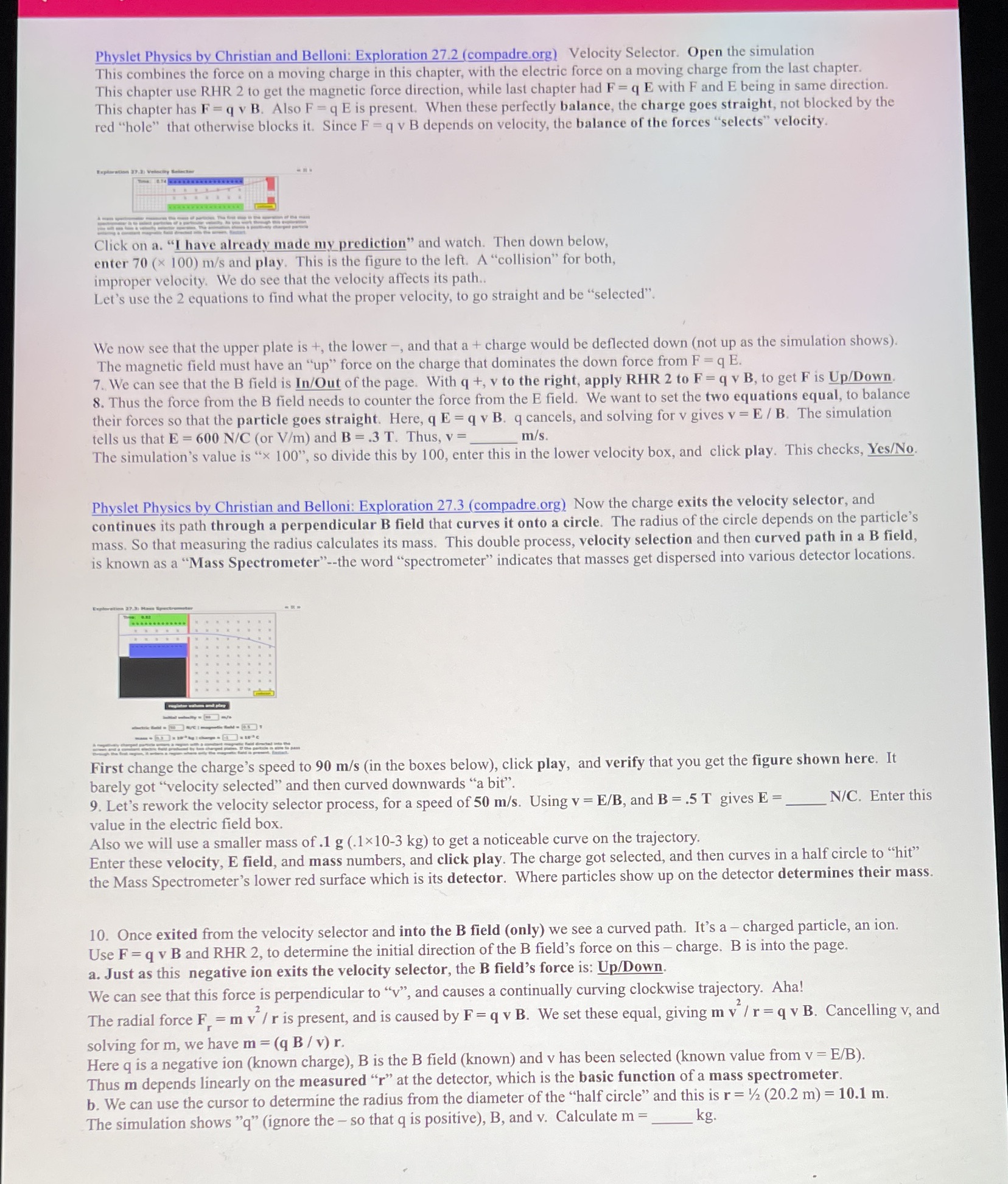https://www.compadre.org/Physlets/electromagnetism/ex27_2.cfmThis is the link for no 7 and 8https://www.compadre.org/Physlets/electromagnetism/ex27_3.cfmThis is the link for no 9 and 10Answer all the bold and underline questions.
Physlet Physics by Christian and Belloni: Exploration 27.2 (compadre.org) Velocity Selector. Open the simulation This combines the force on a moving charge in this chapter, with the electric force on a moving charge from the last chapter. This chapter use RHR 2 to get the magnetic force direction, while last chapter had F = q E with F and E being in same direction. This chapter has F = q v B. Also F = q E is present. When these perfectly balance, the charge goes straight, not blocked by the red "hole" that otherwise blocks it. Since F = q v B depends on velocity, the balance of the forces "selects" velocity. Click on a. "I have already made my prediction" and watch. Then down below, enter 70 (x 100) m/s and play. This is the figure to the left. A "collision" for both, improper velocity. We do see that the velocity affects its path.. Let's use the 2 equations to find what the proper velocity, to go straight and be "selected". We now see that the upper plate is +, the lower -, and that a + charge would be deflected down (not up as the simulation shows). The magnetic field must have an "up" force on the charge that dominates the down force from F = q E. 7. We can see that the B field is In/Out of the page. With q +, v to the right, apply RHR 2 to F = q v B, to get F is Up/Down. 8. Thus the force from the B field needs to counter the force from the E field. We want to set the two equations equal, to balance their forces so that the particle goes straight. Here, q E = q v B. q cancels, and solving for v gives v = E / B. The simulation tells us that E = 600 N/C (or V/m) and B = .3 T. Thus, v =_ m/s. The simulation's value is "x 100", so divide this by 100, enter this in the lower velocity box, and click play. This checks, Yes/No. Physlet Physics by Christian and Belloni: Exploration 27.3 (compadre.org) Now the charge exits the velocity selector, and continues its path through a perpendicular B field that curves it onto a circle. The radius of the circle depends on the particle's mass. So that measuring the radius calculates its mass. This double process, velocity selection and then curved path in a B field, is known as a "Mass Spectrometer"--the word "spectrometer" indicates that masses get dispersed into various detector locations. ration 27.3: Mama 5p First change the charge's speed to 90 m/s (in the boxes below), click play, and verify that you get the figure shown here. It barely got "velocity selected" and then curved downwards "a bit". 9. Let's rework the velocity selector process, for a speed of 50 m/s. Using v = E/B, and B = .5 T gives E =_ N/C. Enter this value in the electric field box. Also we will use a smaller mass of .1 g (.1x10-3 kg) to get a noticeable curve on the trajectory. Enter these velocity, E field, and mass numbers, and click play. The charge got selected, and then curves in a half circle to "hit" the Mass Spectrometer's lower red surface which is its detector. Where particles show up on the detector determines their mass. 10. Once exited from the velocity selector and into the B field (only) we see a curved path. It's a - charged particle, an ion. Use F = q v B and RHR 2, to determine the initial direction of the B field's force on this - charge. B is into the page. a. Just as this negative ion exits the velocity selector, the B field's force is: Up/Down. We can see that this force is perpendicular to "v", and causes a continually curving clockwise trajectory. Aha! The radial force F = m v / r is present, and is caused by F = q v B. We set these equal, giving mv /r = q v B. Cancelling v, and solving for m, we have m = (q B / v) r. Here q is a negative ion (known charge), B is the B field (known) and v has been selected (known value from v = E/B). Thus m depends linearly on the measured "r" at the detector, which is the basic function of a mass spectrometer. b. We can use the cursor to determine the radius from the diameter of the "half circle" and this is r = 1/2 (20.2 m) = 10.1 m. The simulation shows "q" (ignore the - so that q is positive), B, and v. Calculate m = kg







